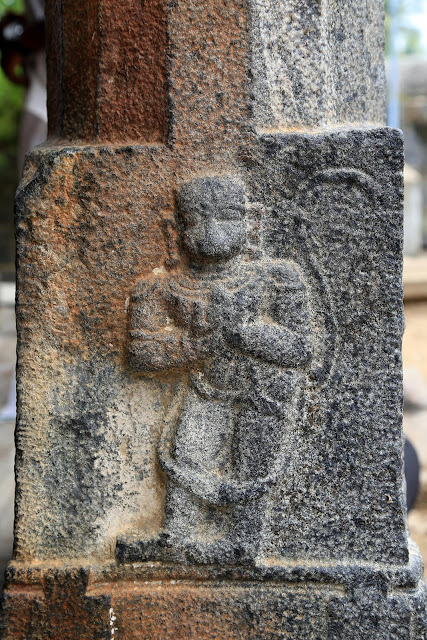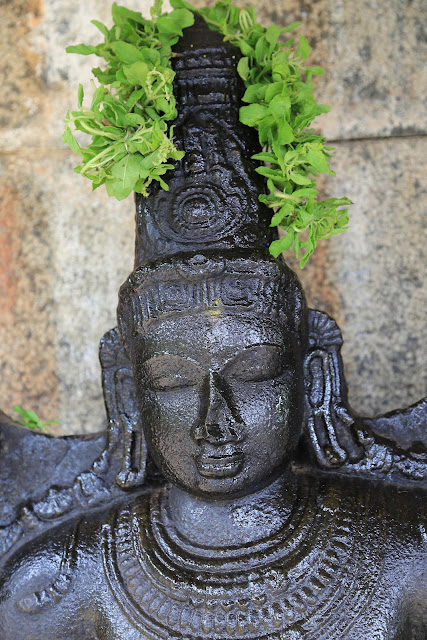Vedha Narayana Perumal Temple, Aanur, Chengalpet,
Kanchipuram
Vedha
Narayana Perumal Temple is dedicated to Hindu God Vishnu located in Aanur
Village near Chengalpet in Kanchipuram District of Tamilnadu. This ancient
temple is in a dilapidated condition. Two years ago, two ancient idols were
stolen from this dilapidated Pallava-era Perumal temple. Vedanarayana Perumal
temple is in a state of disrepair. It is located approximately 13 kms from
Chengalpattu and situated very near River Palar.
In a
totally dilapidated condition, as the roots of trees and creepers have taken a
firm hold on them, the only heartening feature is that worship is still
continued in this temple which follows the Vaikhanasa code. It is only from the
numerous inscriptions etched on the walls of this shrine that one comes to know
that this was an important centre of worship even in the Chola times starting
from the 10th century A.D.
The
Temple
The
entrance to the main temple and also the sanctum-sanctorum face east.
Vedanarayana Perumal enshrined here is seated in the ardha-padmasana posture,
with his left leg placed on the pedestal and right leg placed in front and hold
the conch and discus (Sanghu and Chakram) in his upper left and right hands
respectively. His lower right hand is in the abhaya hasta pose while his lower
left hand in in chin mudra (gesture of teaching).
The
Srivatsa mark is clearly visible on the right hand side of his chest. To his
right and left are Sri Devi and Bhu Devi respectively, also in a seated pose
and sharing the same pedestal with Vedanarayana Perumal. The processional
deity, also of the same name, is four-armed Vishnu in a standing pose holding
the Sankhu and Chakra in his upper arms, his lower right hand in chin mudra and
lower left hand in varada hasta, giving boons to his worshippers.
The
dilapidated mandapa in front, belonging to the Chola times, bears many
sculptures on the pillars like Vamana, Garuda with his palms outstretched,
Vishnu Bhaktas, and many more, but sadly, most of these are worn out due to
lack of proper maintenance.
Stone
images of Rama and Sita, originally in a separate shrine, long since vanished,
on the banks of the River Palar, are now worshipped here, as are the
Utsava-murthis of the other temples in this village. Also seen in this pillared
mandapa are stone images of Lakshmi-Narayana, Vishvaksena, Nammazhwar,
Tirumangai Azhwar and Periazhwar. Two stone icons of Bhakta Anjaneya are kept
here, one of which is unique as the entire image, including the halo are
sculpted out of one single piece of stone. The small shrine for Garuda is
opposite the main sanctum near the mandapa.
Although
this temple is in a dilapidated state, there are many epigraphs found inscribed
on the walls which throws much light on the history of this shrine and the
village of Anoor in the ancient and medieval times. The earliest inscription
seen here belongs to the time of Rajaraja Chola I of the 10th century,
which though damaged records some provision made for worship and offerings to
this temple by the administrative organization of this village.
The
ceiling above the garbagriha and the mantapa has leaks, that when it rains, all
the idols get drenched. Roots of trees have penetrated the walls of the
garbagriha, and threaten the structure. The temple has no electricity.
There
used to be a Rama temple in the village, on the banks of the River Palar. Now
the temple has crumbled completely. The villagers have managed to retrieve the
idols of Rama, Sita and Anjaneya, and have installed them in the Vedanarayana
temple. The Vedanarayana temple is under the control of the HR& CE board,
which must take necessary steps to prevent this temple from destruction.
Inscriptions
The
walls of the Perumal temple have many inscriptions from different periods in
history. One of them, built into the back wall of the temple, is from the 15th
year of the reign of Raja Raja I. It is an inscription, which, when recorded by
R.Krishnaswami Iyengar in 1933, was complete and mentioned Raja Raja’s victory in
Kandalur. However, the reference to Kandalur is now missing. Maybe that portion
of the slab broke off during the repairs in 1933, which incidentally, was the
last time such works were carried out.
Yet
another inscription of Raja Raja I’s period mentions the appointment of a
scholar, to teach the Vedas, Mimamsa, Vritthi, Alankara, Vyakharana, and
Adhyaayi. Adhyaayi must be a reference to Ashtaadhyayi, Panini’s work on
Sanskrit grammar. The word Vakkaanithal is used, indicating that the teacher
had to explain everything in detail.
This
brings to mind the Sri Venkateswara temple in the village of Thirumukkudal,
also situated near Chengalpattu, on the banks of the confluence of the River
Palar and her tributaries the Cheyyar and the Vegavathi, where a large temple-college
functioned in the 11th century A.D. as seen from a long and detailed
11th century inscription of the time of Vira-Rajendra (1062/63-1070 A.D.),
the grandson of Rajaraja I found in that temple.
Every
sale, agreement or donation by anyone had to be preceded by a reference to the
king to be legally binding. If it was a direct grant from the king, then the
inscription would carry the words Konerinmai Kondaan. Not only did the temple
reverberate with Vedic chants, but with the sound of music as well. Again it is
a Raja Raja I period inscription that mentions ‘Tirunaattu Perugachan’ and
‘Eesanan,’ as being the two appointees responsible for playing musical
instruments during Tiruppalli Yezhutchi.
There is
an inscription of the time of Ko Parthibhendradivarma, and he was a Pallava
chieftain, who was one of those who avenged the assassination of Aditya
Karikala, the elder brother of Raja Raja I. A 14th century inscription refers
to the village as Adiyur, Satyasrayakulakala Chaturvedimangalam, and as
Chitramezhi Vinnagaram.
The
slabs with the inscriptions have all been jumbled up, maybe during the 1933
renovation, and some of them have been fixed upside down. This place used to be
called Dakshina Prayag, because of its proximity to Mukkoodal, where there is a
confluence of three rivers.
There is
a reference to a Karunakaran Mutt in the village, in an inscription. This
surmises that this mutt must have been established in honour of Karunakaran,
the general of Kulottunga I. Karunakaran is the hero of the literary work — Kalingattuparani.
Outside the Siva temple, on the roadside, is a slab that bears an inscription
of the time of Parantaka Chola I.
Temple
Opening Time
The
temple is open only in the mornings between 7am to 8 am.
Contact
Vedha
Narayana Perumal Temple,
Aanur,
Chengalpet,
Kanchipuram
District,
Mobile: +91 – 95510 66441
Mobile: +91 – 98417 16694
Connectivity
Aanur is
located at around 13 kms South of Chengalpet. While going from Chennai, we have
to go through the Chengalpet town and after passing the Chengalpet court in the
outskirts of the town, we have to go straight towards Pon Vilaintha Kalathur
and then further go straight beyond P.V.Kalathur for another 4-5 kms to reach
Aanoor which is located on the Eastern bank of Palar river.
References



































